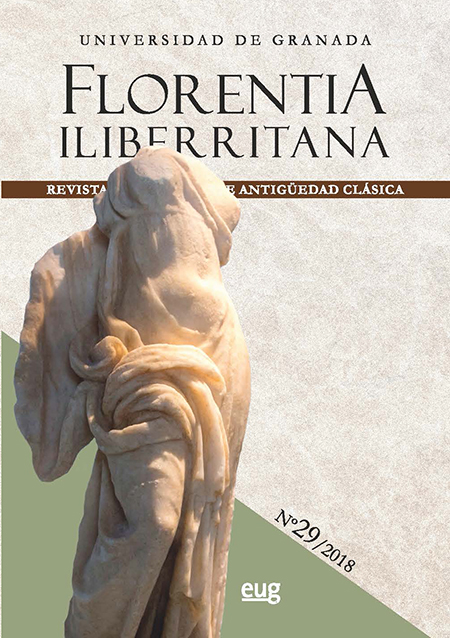Patrones métricos y estructuras épicas
Palabras clave:
schémas métriques, hexamètre spondaïque, composition, ÉnéideResumen
¿Los patrones métricos proporcionan indicaciones sobre la composición del texto épico? Siguiendo el trabajo de GE Duckworth en la canción IV de la Eneida, el estudio de estos patrones revela en realidad la atención llevada por el poeta a la composición microestructural más que a la macroestructural gracias al uso de patrones opuestos, inversos o idénticos, incluso como el espondaico. hexámetro.Descargas
Citas
ADEMA S. M., «The Tense of Speech Indications in Vergil’s Aeneid» in Papers of Grammar 9. Latina lingua ! Nemo te lacrimis decoret neque funera fletu faxit. Cur? Volitas uiua per ora uirum: proceedings of the twelfth international colloquium on Latin linguistics (Bologna, 9-14 June 2003), G. Calboli (ed.), Rome, 2005, p. 469-431.
AUSTIN R.G., 1955, P. Vergili Maronis Aeneidosliber quartus, Oxford. CECCARELLI L., 2008, Contributi per la storiadell’esametro latino, Rome, 2 vol.
ChAUSSERIE-LAPRéE J.-P., 1969, L’expression narrative chez les historiens latins. Histoire d’un style, Paris.
DANGEL J., «L’héritage des genres grecs à Rome: épopée et tragédie, une géné- ricité traversière», BAGB 2, 2 (2009), p. 146-164.
DE NEUBOURG L., 1986, La base de la localisation des mots dans l’hexamètre latin, Bruxelles.
DROBISh M. W., «Ein statisticher Versuch über die Formen des lateinischen hexameters», Sb. S. A.W. 20 (1866), p. 75-139.
DUCKWORTh G. E., 1962, Structural Patterns and Proportions in Vergil’sAe- neid. A Study in Mathematical Composition, Ann Arbor.
DUCKWORTh G.E., «Variety and Repetition in Vergil’shexameters», TAPhA 95 (1964), p. 9-65.
DUCKWORTh G. E., «horace’shexameters and the Date of the Ars Poetica», TAPhA 96 (1965), p. 73-95.
DUCKWORTh G. E., «Studies in Latin hexameter Poetry», TAPhA 97 (1966), p. 67-113.
DUCKWORTh G. E., «Five Centuries of Latin hexameterPoetry: Silver Age and Late Empire», TAPhA 98 (1967), p. 77-150.
DUCKWORTh G. E., «A Rare Typeof First Foot Dactyl (ThreeWords)», AJPh 89 (1968), p. 437-448.
DUCKWORTh G. E., 1969, Vergil and Classical Hexameter Poetry. A Study in Metrical Variety, Ann Arbor.
hEINzE R., 1993, Virgil’s Epic Technique, tr. h. hazel, D. harvey, F. Robertson, Bristol (Leipzig, 1915).
hIGhET G., 1972, The Speeches in Vergil’s Aeneid, Princeton.
KOLLMANN E. D., «zum Enjambement in der lateinischen hexameterdichtung», RhM 125 (1982), p. 117-134.
KRUMMEN E., «Dido als Mänade und tragische heroine: dionysische Thematik und Tragödientradition in Vergils Didoerzählung», Poetica 1, 36 (2004), p. 25-69.
LAIRD A., 1999, Powers of Expression, Expressions of Power. Speech Presen- tation and Latin Literature, Oxford.
LOUTSCh Cl., «énée face à Didon (Énéide IV, 333-361)», Exercices de rhéto- rique (en ligne), 2 (2013), mis en ligne le 28 janvier 2014, consulté le 25 avril 2018. URL: http://journals.opendition.org/.
MINICONI P.-J., 1955, Étude des thèmes guerriers de la poésie gréco-romaine, Paris.
PEROTTI P. A., «Il libro di Didone: una tragedia nell’Eneide», Prometheus 26 (1990), p. 238-244.
SOUBIRAN J., «Passion de Didon. Métrique de Virgile», Pallas 10 (1961), p. 31-65.
SOUBIRAN J., «Les hexamètres spondaïques à quadrisyllabe final», GIF 21 (1969), p. 329-349.
SWANEPOEL J., «Infelix Dido: Vergil and the notion of the tragic» Akroterion 1, 40 (1995), p. 30-46.
WLOSOK A., «Vergils Tragödie: ein Beitragzum Problem des Tragischen in der Aeneis», in h. Görgemanns, E. A. Schmidt(eds), Studien zum antiken Epos, Meisenheim a. Gl., 1976, p. 228-250.
YEh W.-J., 2007, Structures métriques des poésies de Pétrone: pour quel art poétique?, Louvain-Paris-Dudley, Ma.












